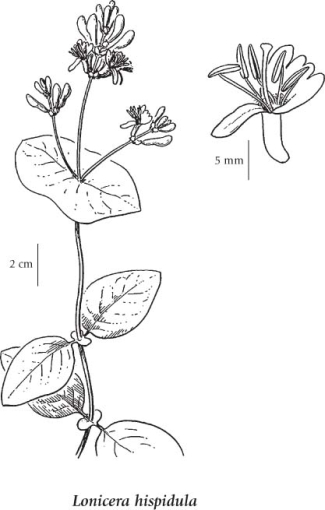Click on the image below to view an
expanded illustration for this species.

|
General:
Partially evergreen, woody vine or sprawling shrub, 1-6 m long/tall; twigs hollow, usually short-hairy, glaucous when young.
Leaves:
Opposite, on stalks 3-5 mm long, some with paired, fused stipules between the leaf stalks, oblong to egg-shaped, 2-8 cm long, 1.5-5 cm wide, often somewhat heart-shaped at the base, obtuse at the tip, usually stiffly hairy, sometimes glabrous, glaucous beneath; upper pairs joined to form disks around the stem.
Flowers:
Inflorescence of stalked and clustered flowers in compact whorls forming short, interrupted spikes terminal and axillary on long stalks that are glabrous to glandular hairy; corollas whitish, pink, or yellowish, sometimes purplish, 12-20 mm long, tubular below, the tubes bulging on one side above the base 2-lipped above, the upper lips 4-lobed, the lobes recoiled, lips as long as or longer than the tubes.
Fruits:
Berries, red, 0.8-1 cm thick, several-seeded.
Source: The Illustrated Flora of British Columbia
|
